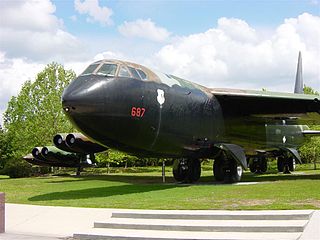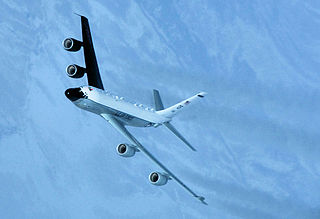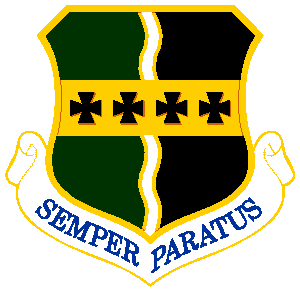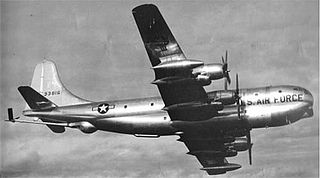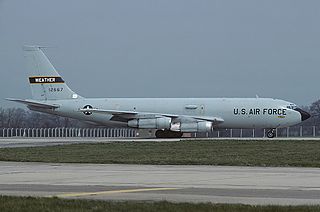- Second Air Force, 25 Nov 1953 –1 Apr 1963, B-47E
- 20th Bombardment Squadron
- 49th Bombardment Squadron
- 96th Bombardment Squadron
- 429th Bombardment Squadron (1958–1962)*
- Wing transferred to Barksdale AFB, Louisiana in 1963; 20th BS converted to B-52F Stratofortress
- Fifteenth Air Force, 1 Nov 1952 –15 Mar 1963, B-47B/E; EB-47E**
- 1st Bombardment Squadron
- 5th Bombardment Squadron
- 99th Bombardment Squadron
- 658th Bombardment Squadron (1958–1962)*
- Wing transferred to Beale AFB, California in 1966; 1st and 99th BS converted to Lockheed SR-71 Blackbird
- Pinecastle AFB, Florida, Jun 1954 – Jul 1956
- Homestead AFB, Florida, Jul 1956 – Jan 1961
- Second Air Force, 11 Jun 1954 –1 Jan 1961, B-47E
- 28th Bombardment Squadron
- 30th Bombardment Squadron (to 4133d SW, B-52H in 1961)
- 93d Bombardment Squadron (to 4239th SW, B-52H in 1961)
- 659th Bombardment Squadron (1958–1961)*
- Converted to B-52F Stratofortress in 1962
- Fifteenth Air Force, 1 Nov 1952 –15 Mar 1963, B-47B/E
- 2d Bombardment Squadron
- 19th Bombardment Squadron
- 33d Bombardment Squadron
- 408th Bombardment Squadron (1959–1962)*
- Converted to B-52B Stratofortress in 1963
- Smoky Hill (later Schilling) AFB, Kansas, 28 May 1952 –20 Jun 1960
- Forbes AFB, Kansas, 20 Jun 1960 –1 Sep 1965
- Fifteenth Air Force (1952–1960), Second Air Force, 1960–1964, B-47E
- 25th Bombardment Squadron
- 44th Bombardment Squadron
- 45th Bombardment Squadron
- 660th Bombardment Squadron (1959–1960)
- Inactivated 1 September 1964
- Fifteenth Air Force, 25 Sep 1953 –15 Mar 1960, B-47E
- 63d Bombardment Squadron
- 64th Bombardment Squadron
- 65th Bombardment Squadron
- 403d Bombardment Squadron (1958–1960)*
- Converted to B-58 Hustler at Carswell AFB, Texas in 1960
- Lake Charles (later Chennault) AFB, Louisiana
- Second Air Force, 25 Apr 1953 –15 Jun 1960, B-47B/E
- 66th Bombardment Squadron
- 67th Bombardment Squadron
- 68th Bombardment Squadron
- 506th Bombardment Squadron (1958–1960)*
- Inactivated 15 June 1960; became 44th Strategic Missile Wing at Ellsworth
- Lake Charles (later Chennault) AFB, Louisiana
- Second Air Force, 25 Oct 1953 –15 Apr 1963, B-47E
- 51st Bombardment Squadron
- 52d Bombardment Squadron
- 656th Bombardment Squadron
- 657th Bombardment Squadron (1958–1963)*
- Wing transferred to Seymour Johnson AFB, North Carolina in 1963; 51st BS converted to B-52G Stratofortress
- Fifteenth Air Force, 15 Apr 1954 –1 Feb 1955, B-47E
- 328th Bombardment Squadron
- 329th Bombardment Squadron
- 330th Bombardment Squadron
- Functioned as a SAC Training Wing – Not Operational; Wing converted to B-52B Stratofortress in 1956
- Second Air Force, Altus AFB, Oklahoma, 18 Nov 1953 –3 Sep 1957, B-47E
- Fifteenth Air Force, Dyess AFB, Texas, 4 Sep 1957 –18 Mar 1963, B-47E
- 337th Bombardment Squadron
- 338th Bombardment Squadron
- 339th Bombardment Squadron
- 413th Bombardment Squadron (1958–1961)*
- Converted to B-52E Stratofortress in 1962
- Fifteenth Air Force, 1 Apr 1955 –1 Oct 1959, B-47E
- 340th Bombardment Squadron
- 341st Bombardment Squadron (to 4038th SW, B-52G in 1960)
- 342d Bombardment Squadron (to 4137th SW, B-52G in 1960)
- Wing transferred to Blytheville AFB, Arkansas in 1959; 340th BS converted to B-52G Stratofortress
- Lincoln AFB, Nebraska, B-47E
- Fifteenth Air Force, 15 Oct 1954 –31 Dec 1958 (98th BMW)
- Second Air Force, 1 Jan 1959 –25 Jun 1966 (98th SAW after 1 Feb 1964)
- 343d Bombardment Squadron
- 344th Bombardment Squadron
- 345th Bombardment Squadron
- 415th Bombardment Squadron (1958–1962)*
- Inactivated 25 June 1966
- Portsmouth (later, Pease) AFB, New Hampshire
- Eighth Air Force, 1 Jan 1956 –25 Jun 1966, B-47E
- 349th Bombardment Squadron
- 350th Bombardment Squadron
- 351st Bombardment Squadron
- 418th Bombardment Squadron (1959–1962)*
- Wing transferred to Davis-Monthan AFB, Arizona in 1966; converted to Lockheed U-2
- Second Air Force, 20 Jun 1953 –15 Apr 1958
- Eighth Air Force, 16 Apr 1958 –15 Jun 1964
- B-47B/E, 1953–1958, 1958–1961; RB-47, 1958; EB-47E**, 1961–1964
- 32d Bombardment Squadron
- 352d Bombardment Squadron
- 353d Bombardment Squadron
- 419th Bombardment Squadron (1958–1961)*
- Became KC-135 Air Refueling Wing in 1964
- Fifteenth Air Force, 20 Jan 1953 –15 Jun 1964, B-47B/E
- 358th Bombardment Squadron
- 359th Bombardment Squadron
- 360th Bombardment Squadron
- 427th Bombardment Squadron (1958–1961)*
- Inactivated 15 June 1964
| - Fifteenth Air Force, MacDill AFB, Florida, 15 Apr 1952 –15 Feb 1961, B-47B/E
- Second Air Force, Bunker Hill AFB, Indiana, 16 Feb 1961 –1 Apr 1963, B-47E
- 364th Bombardment Squadron
- 365th Bombardment Squadron
- 366th Bombardment Squadron
- 422d Bombardment Squadron (1960–1961)
- Converted to B-58 Hustler in 1961
- Second Air Force, 306th BMW, 2 Apr 1951 –1 Jan 1959, B-47A/B/E***
- Second Air Force, 306th SAW, 1 Jan 1959 –1 Apr 1963, B-47E
- 367th Bombardment Squadron
- 368th Bombardment Squadron
- 369th Bombardment Squadron
- 423d Bombardment Squadron (1959–1962)*
- Wing transferred to McCoy AFB, Florida in 1963; 367th BS converted to B-52D Stratofortress
- Fifteenth Air Force, 8 Nov 1954 –30 Dec 1958, B-47E
- Second Air Force, 31 Dec 1958 –25 Jun 1965, B-47E; EB-47L (1962-1964)
- 370th Bombardment Squadron
- 371st Bombardment Squadron
- 372d Bombardment Squadron
- 424th Bombardment Squadron (1958–1961)*
- Inactivated 25 March 1965
- Second Air Force, 25 Sep 1952 –25 Jun 1961, B-47B/E
- 373d Bombardment Squadron
- 374th Bombardment Squadron
- 375th Bombardment Squadron
- 425th Bombardment Squadron (1958–1961)*
- Became non-operational 15 Jul 1959; Wing transferred to Little Rock AFB, Arkansas and converted to LGM-25C Titan II ICBMs (373d 374th SMS) in 1963.
- Second Air Force, 10 May 1954 –30 Dec 1958, B-47E
- Fifteenth Air Force, 31 Dec 1958 –25 Feb 1965, B-47E
- 379th Bombardment Squadron
- 380th Bombardment Squadron
- 381st Bombardment Squadron
- 428th Bombardment Squadron (1959–1962)*
- Inactivated 25 June 1965
- Fifteenth Air Force, 23 Jul 1953 –15 Sep 1960
- YRB-47B, 1953+; B-47E, 1953–1960
- 441st Bombardment Squadron
- 442d Bombardment Squadron
- 443d Bombardment Squadron
- 444th Bombardment Squadron (1959–1960)*
- Converted to B-52F Stratofortress (441st BS) in 1963
- Second Air Force, 15 Dec 1953 –1 Jan 1959, B-47B/E
- Eighth Air Force, 1 Jan 1959 –25 Oct 1961, B-47E
- 445th Bombardment Squadron
- 446th Bombardment Squadron
- 447th Bombardment Squadron
- 448th Bombardment Squadron
- Inactivated 25 October 1961
- Fifteenth Air Force, 8 Aug 1953 –30 Dec 1958
- Second Air Force, 31 Dec 1958 –1 Sep 1963
- YRB-47B, 1954-1955+; B-47E, 1955–1963
- 486th Bombardment Squadron
- 487th Bombardment Squadron
- 488th Bombardment Squadron
- 489th Bombardment Squadron (1958–1962)*
- Inactivated 1 September 1963
- Fifteenth Air Force, 1 Sep 1955 –25 Jun 1961, B-47E
- 10th Bombardment Squadron
- 12th Bombardment Squadron
- 490th Bombardment Squadron
- 491st Bombardment Squadron (1958–1961)*
- Inactivated 25 Jun 1961
- Second Air Force, Barksdale AFB, Louisiana, 23 Feb 1954 –14 Nov 1957, B-47E
- Eighth Air Force, Lockbourne AFB, Ohio, 15 Nov 1957 –15 Mar 1955, B-47E, 1957–1961; EB-47L++, 1961–1965
- 512th Bombardment Squadron
- 513th Bombardment Squadron
- 514th Bombardment Squadron
- 515th Bombardment Squadron (1958–1961)*
- Inactivated 15 March 1965
- Second Air Force, 1 Nov 1955 –1 Jan 1959, B-47E
- 524th Bombardment Squadron
- 525th Bombardment Squadron (to 4136th SW, B-52H in 1961)
- 526th Bombardment Squadron (to 4042d SW, B-52H in 1961)
- 527th Bombardment Squadron (1958–1959)*
- Transferred to Wurtsmith AFB, Michigan; converted to B-52H Stratofortress (524 BS) in 1961
- Second Air Force, 1 Jul 1955 –25 Jun 1965
- B-47E, 1955–; EB-47E** 1962–1964
- 528th Bombardment Squadron
- 529th Bombardment Squadron
- 530th Bombardment Squadron
- 531st Bombardment Squadron (1959–1961)*
- Converted to B-52G Stratofortress (528th BS) in 1966
- Second Air Force, 1 Aug 1955 –2 Apr 1966, B-47E
- 544th Bombardment Squadron
- 545th Bombardment Squadron
- 546th Bombardment Squadron
- 547th Bombardment Squadron (1958–1961)*
- Inactivated 1 September 1964
- Fifteenth Air Force, Walker AFB, New Mexico, 1 Jul 1955 –30 Jun 1958, B-47E
- Eighth Air Force, Pease AFB, New Hampshire, 1 Jul 1958 –2 Apr 1966, B-47E
- 393d Bombardment Squadron
- 715th Bombardment Squadron
- 830th Bombardment Squadron
- 661st Bombardment Squadron (1959–1962)*
- Converted to B-52D Stratofortress (393d BS) in 1966
|






